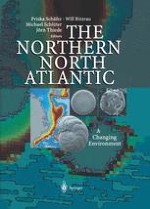2001 | OriginalPaper | Chapter
Changes in the Hydrate Stability Zone on the Norwegian Margin and their Consequence for Methane and Carbon Releases Into the Oceanosphere
Authors : Jürgen Mienert, Jörg Posewang, Dirk Lukas
Published in: The Northern North Atlantic
Publisher: Springer Berlin Heidelberg
Included in: Professional Book Archive
Activate our intelligent search to find suitable subject content or patents.
Select sections of text to find matching patents with Artificial Intelligence. powered by
Select sections of text to find additional relevant content using AI-assisted search. powered by
The presence of gas hydrates in oceanic sediments along the Norwegian Continental Margin is documented in high-frequency near-vertical and wide-angle seismic reflection data. The base of the hydrate stability zone (HSZ) is detected in reflection seismic sections by the occurrence of a strong bottom simulating reflector (BSR). Below the BSR, a low-velocity layer is interpreted as a gas-bearing zone. Modeling of the HSZ as a function of temperature and pressure shows a distinct thinning of the HSZ at the Norwegian Margin from the Last Glacial Maximum (LGM) to the present time. This highly dynamic HSZ system can release large amounts of methane from subseafloor hydrate reservoirs into the oceanosphere. Based on these modeling results, considerable amounts of carbon have left the submarine hydrate reservoirs of the Norwegian Continental Margin area since the LGM. A reasonable estimation for the released methane total volume (Standard Temperature and Pressure (STP)) lies between 3 and 13.1013m3 and for carbon mass between 16 and 67 GT.
